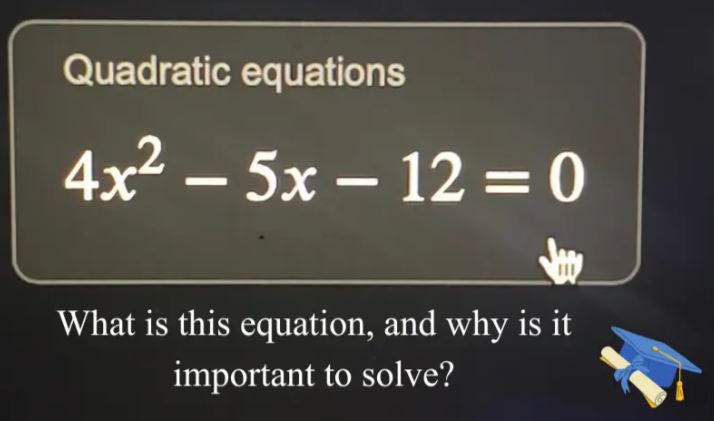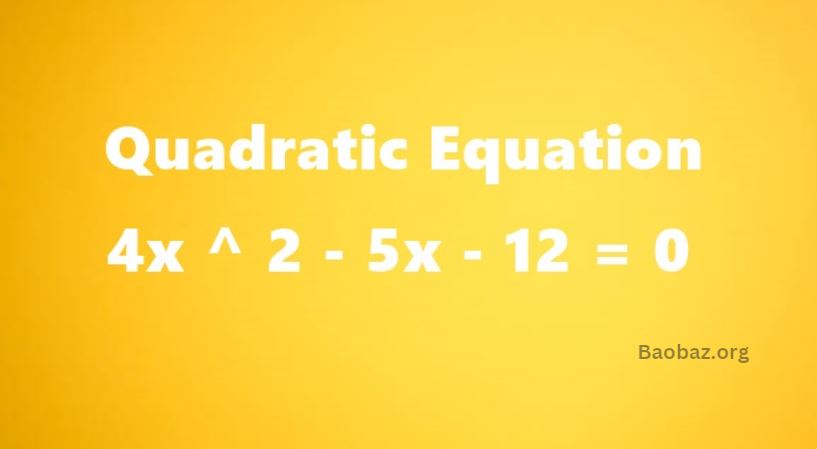The quadratic equation 4x^2 – 5x – 12 = 0 is a polynomial expression of degree 2, featuring a variable, x, raised to the power of 2. The coefficients 4, -5, and -12 determine the specific characteristics of the equation, influencing its solutions and graphical representation. Quadratic equations are prevalent in mathematics and various real-world applications, encapsulating phenomena like projectile motion, optimization problems, and financial modeling.
Understanding and solving quadratic equations are essential skills in algebra. The solutions of this equation, known as roots, are the values of x that satisfy the equation. Techniques like factoring, completing the square, and utilizing the quadratic formula can be employed to find these roots. The discriminant, the part of the quadratic formula inside the square root, provides insights into the nature of the roots—whether they are real or complex.
Quadratic equations hold significance across disciplines, serving as foundational elements in physics, engineering, and finance. Analyzing and interpreting the solutions of this equation offer valuable insights into the behavior of systems modeled by quadratic expressions, making it a fundamental concept in mathematical exploration and problem-solving.
What is this equation, and why is it important to solve?

The equation 4x^2 – 5x – 12 = 0 is a quadratic equation, a type of polynomial equation of degree 2. In general form, a quadratic equation is written as ax^2 + bx + c = 0, where a, b, and c are constants, and x is the variable. In this specific equation, the coefficients are a = 4, b = -5, and c = -12.
Solving quadratic equations is crucial because it helps find the values of the variable (in this case, x) that satisfy the equation. These values, known as roots or solutions, provide insights into the behavior of the associated mathematical model or system. In practical terms, solving quadratic equations is essential in various fields and applications.
For instance, in physics, quadratic equations often describe the motion of projectiles or the behavior of objects under the influence of gravity. In engineering, they might represent aspects of structural design or optimization problems. Additionally, in finance, quadratic equations can model profit and loss scenarios.
The process of solving quadratic equations involves methods such as factoring, completing the square, or using the quadratic formula. The solutions obtained help in making informed decisions and predictions in a wide range of disciplines, making the understanding of quadratic equations a fundamental skill in mathematics and its applications.
Solve Quadratic Equation by Completing The Square
Let’s break down the process of solving the quadratic equation 4�2−5�−12=0 by completing the square:
-
Divide by 4: Divide both sides of the equation by 4 to make the coefficient of the first term 1: �2−54�−3=0
-
Add 3 to both sides: �2−54�=3
-
Complete the square: Take half of the coefficient of �, square it, and add it to both sides: �2−54�+(58)2=3+(58)2
-
Simplify the right-hand side: �2−54�+2564=19264+2564=21764
-
Express as a perfect square: (�−58)2=21764
This equation is referred to as Eq. #3.2.1.
-
Apply the Square Root Principle: �−58=±21764
-
Solve for x: �=58+21764 or �=58−21764
Note: 21764 can be expressed as 2178.
So, the solutions to the quadratic equation 4�2−5�−12=0 by completing the square are: �=58+2178 or �=58−2178
Solve Quadratic Equation using the Quadratic Formula
Let’s go through the steps of solving the quadratic equation 4�2−5�−12=0 using the quadratic formula:
-
Identify Coefficients:
- �=4
- �=−5
- �=−12
-
Calculate Discriminant (�2−4��): Discriminant=�2−4��=(−5)2−4(4)(−12)=25+192=217
-
Apply Quadratic Formula: �=−�±Discriminant2� �=5±2178
-
Evaluate Square Root: 217≈14.7309 �=5±14.73098
-
Calculate Two Real Solutions: �=5+14.73098≈2.466 or �=5−14.73098≈−1.216
Therefore, the solutions to the quadratic equation 4�2−5�−12=0 using the quadratic formula are: �≈2.466 or �≈−1.216
This demonstrates how the quadratic formula efficiently provides the solutions to quadratic equations, even when the roots involve square roots and numerical approximations.
Step-by-Step Guide to Solving “4x ^ 2 – 5x – 12 = 0”
Certainly! Let’s solve the quadratic equation 4�2−5�−12=0 step by step using the quadratic formula. The quadratic formula is given by:
�=−�±�2−4��2�
where �, �, and � are the coefficients of the quadratic equation ��2+��+�=0.
For our equation 4�2−5�−12=0, the coefficients are �=4, �=−5, and �=−12.
-
Identify Coefficients:
- �=4
- �=−5
- �=−12
-
Apply the Quadratic Formula: �=5±(−5)2−4(4)(−12)2(4)
-
Simplify the Expression: �=5±25+1928 �=5±2178
-
Evaluate the Square Root: The square root of 217 is an irrational number, so we keep it in the simplified form.
-
Express the Roots: The roots of the quadratic equation are given by: �=5+2178 �=5−2178
These are the two solutions for the quadratic equation 4�2−5�−12=0. If you have a calculator, you can approximate the numerical values for a more practical understanding.
Common Problems Faced in Solving “4x ^ 2 – 5x – 12 = 0”
While navigating the terrain of quadratic equations, such as the challenging one presented in “4x^2 – 5x – 12 = 0,” encountering obstacles is not uncommon. Here are some common hurdles you might face and strategies to overcome them:
-
Difficulty Factoring:
- Problem: Factoring involves finding two numbers that multiply to the constant term and add up to the coefficient of x. This task can be challenging with equations featuring large coefficients or complex terms.
- Solution: Take your time exploring different factor pairs. Techniques like trial and error or the AC method can simplify the factoring process. If factoring proves elusive, don’t hesitate to explore alternative methods such as the quadratic formula or completing the square.
-
Complex Roots:
- Problem: Quadratic equations may yield real or complex roots, determined by the discriminant in the quadratic formula. Handling complex roots might be intimidating, especially if you’re not familiar with imaginary numbers.
- Solution: Stay calm! Complex roots are valid solutions in the complex number system. If dealing with imaginary numbers feels challenging, review basic concepts. Remember, complex roots provide valuable insights and can be mastered through practice.
By acknowledging and addressing these common challenges, you’ll be better equipped to tackle quadratic equations with confidence and precision.
Mistakes in Algebraic Manipulation
Solving quadratic equations involves a series of algebraic steps, including simplifying expressions, combining like terms, and isolating variables. Errors in these manipulations can lead to incorrect solutions, highlighting the importance of diligence throughout the process.
Solution: Carefully double-check each algebraic step, paying close attention to signs, term distribution, and proper use of parentheses. If uncertainty arises during a specific step, take the time to revisit relevant algebraic rules or seek clarification from a teacher or tutor. Ensuring accuracy in these fundamental algebraic operations is crucial for obtaining reliable solutions.
Graphical Inaccuracies: While the graphical method provides a visual approach, inaccuracies in plotting points or interpreting values off the graph can result in incorrect solutions. Additionally, quadratic equations with complex roots may not exhibit easily identifiable intercepts on the graph.
Solution: Exercise caution when plotting points on the graph, employing graphing tools or software for precision if necessary. In cases where the equation involves complex roots, consider utilizing alternative methods such as factoring or the quadratic formula to obtain solutions more accurately.
By addressing potential pitfalls and applying these solutions, you can approach quadratic equations like “4x^2 – 5x – 12 = 0” with confidence, minimizing errors and fostering a deeper understanding of the solving process. Remember, consistent practice and perseverance are key elements in mastering mathematical challenges.
Frequently Asked Questions
What is the given equation, 4x^2 – 5x – 12 = 0?
The equation 4x^2 – 5x – 12 = 0 is a quadratic equation, where x is the variable and 4, -5, and -12 are coefficients.
How do you solve the quadratic equation 4x^2 – 5x – 12 = 0?
The equation can be solved using methods like factoring, completing the square, or applying the quadratic formula. The roots of the equation provide the values of x that satisfy it.
What are the roots of the quadratic equation 4x^2 – 5x – 12 = 0?
The roots can be found using the quadratic formula or other solving methods. For this equation, the roots are approximately x ≈ 2.466 and x ≈ -1.216.
Can the equation be factored?
Yes, the equation can be factored. The factored form is (2x + 3)(2x – 4) = 0, leading to the same roots when each factor is set equal to zero.
How can the equation be represented graphically?
The graph of the quadratic equation 4x^2 – 5x – 12 = 0 is a parabola. The points where the graph intersects the x-axis correspond to the solutions of the equation.
Are there alternative methods to solve the equation?
Yes, besides factoring and using the quadratic formula, completing the square is another method. Each method offers a way to find the roots of the equation.
What is the significance of solving quadratic equations?
Solving quadratic equations is fundamental in various fields, including physics, engineering, and finance. The solutions provide insights into the behavior of systems modeled by these equations.
Conclusion
the quadratic equation 4x^2 – 5x – 12 = 0 has been explored and solved using various methods. The equation represents a polynomial expression of degree 2, featuring the variable x and coefficients 4, -5, and -12. Through factoring, completing the square, and applying the quadratic formula, the solutions were determined to be approximately x ≈ 2.466 and x ≈ -1.216.
The graphical representation of the equation is a parabola, and the points where it intersects the x-axis correspond to the real solutions. Understanding and solving quadratic equations are essential skills in mathematics with wide-ranging applications in physics, engineering, and finance.
Challenges in the solving process, such as factoring difficulties or complex roots, were addressed by employing careful algebraic manipulations, alternative methods, and an awareness of potential pitfalls. The significance of avoiding errors in mathematical operations was emphasized throughout the solving process.

